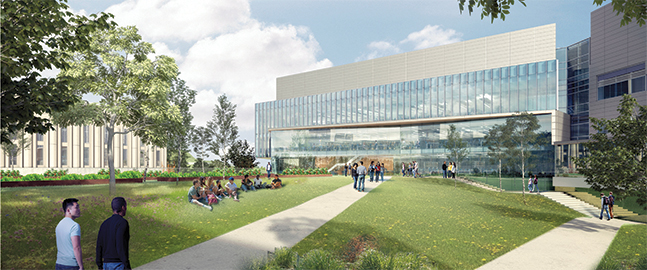Brandeis To Expand Its Science Enterprise
The Science 2A project will construct and renovate 100,000 square feet of facility space, helping the university recruit and retain top faculty and students.

Courtesy Payette
by Jarret Bencks
In late 2023, Brandeis will begin construction on the next phase of a revitalization of the university’s scientific enterprise that began more than a decade ago.
The project, currently called Science 2A, is the second phase of an overhaul of campus science facilities that kicked off with the construction of the Shapiro Science Center, which opened in 2009. Science 2A will add approximately 100,000 square feet of new and renovated space for wet labs, core facilities, state-of-the-art classrooms, and maker space.
As part of the project, a new five-story building will be constructed next to the Shapiro Science Center. Approximately 75% of the building, which will be ADA compliant, will be used for flexible research labs; the remainder will be devoted to learning spaces and other support facilities. Maker lab space on the first floor will expand the capabilities of the Brandeis MakerLab, currently located in Farber Library.
Overall, the Science 2A project will bolster Brandeis’ recruitment and retention of top faculty and students, strengthen the university’s position as a scientific leader, and enhance interdisciplinary connections across campus.
“Brandeis’ science enterprise is a vibrant, thriving part of the university with growing student demand,” says President Ron Liebowitz. “This sweeping new construction project will create a welcoming environment that will meet that demand. One can’t help but be excited after reviewing the plans for this project. I am confident we will see life-changing discoveries — and world-changing scientists — emerge from our revitalized science complex.”
The new facilities will also expand capacity in applied sciences, a key to the creation of a new engineering science program, which was approved by the university’s Board of Trustees in 2021 and is anticipated to be launched by the 2026-27 academic year.
“This is an exciting period at Brandeis,” says Carol A. Fierke, GSAS PhD’84, the university’s provost, executive vice president for academic affairs, and co-chair of the Science Advisory Council. “The improvements to the science complex will reinvigorate our commitment to scientific discovery, allow greater flexibility to follow innovative ideas wherever they may lead, and expand research and teaching capabilities. This is part of the foundation for the next generation of great discoveries by our faculty and students.”
“From the beginning of this process, we have been in lockstep with the provost’s office, finance and administration, and institutional advancement to ensure this project moves forward with the resources necessary for implementation,” says Lois Stanley, vice president for campus planning and operations. “The building will be handsome, but functionality and sustainability are just as important.”
In April, Compass Project Management became the owner’s project manager for the expansion. In August, Payette, the Boston-based firm that oversaw the Shapiro Science Center’s design process, was named the architect. Construction is expected to begin in late 2023, last two to three years, and cost about $145 million. Authorization to issue a bond to support the project’s financing was approved by the Board of Trustees in 2022, and fundraising initiatives are underway.
“This is such an extraordinary opportunity for philanthropists who are committed to bringing the vision for science at Brandeis to life,” says Hannah Peters, interim senior vice president of institutional advancement. “We are thrilled to partner with the scientists and architects to make this important space a reality.”
The project will also include a partial renovation of the Gerstenzang Science Library, removal of the Edison-Lecks Science Building’s upper floors, and conversion of the paved courtyard nicknamed “Red Square” into green space and walking paths.
“We are envisioning a transformational change for this outdoor space,” says Ginelle Lang, director of campus planning. “From the accessible pathways from one building to another to the more inviting landscaping, this will be a place to connect.”
Conceptual planning for the Science 2A project began in February 2021, when the university hired Payette to create initial concepts and prototypes. During the planning and construction phases, Science 2A will be governed by a project sponsor group co-chaired by Fierke and Stew Uretsky, executive vice president for finance and administration.
“By building new space, and incorporating and renovating useful existing spaces, this project will sustainably provide a larger home for discovery and collaboration in the sciences,” Uretsky says. “Science 2A will enable our faculty and students to expand their research activities and connect across disciplines.”
Liebowitz has charged the project sponsor group with overseeing the major capital project’s programming, budget, space-use guidelines, and schedule. The design team will meet with stakeholders to gather input on labs, classrooms, and other program components.
“The plans to construct a new science building make Brandeis’ commitment to the sciences clear,” says Bulbul Chakraborty, the Enid and Nate Ancell Professor of Physics and head of the Division of Science. “We look forward to continuing with a deeply collaborative process as the design takes shape.”
